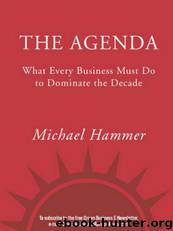The Agenda: What Every Business Must Do to Dominate the Decade by Michael Hammer

Author:Michael Hammer [Hammer, Michael]
Language: eng
Format: mobi
Publisher: The Crown Publishing Group
Published: 2002-04-22T14:00:00+00:00
decision rights matrix, this document specified the roles different managers would play when various major decisions had to be made, such as changing a process design, hiring people, or setting a budget. It detailed which managers would actually make the decision, which had to be consulted beforehand, and which had to be informed afterward.
In effect, the decision rights matrix became the organization’s road map for managerial collaboration. Ironically, once the matrix was developed, Duke’s managers found that they rarely had to consult it. The process of developing it led them to internalize it. The document’s clarity gave the managers a concrete sense of how the new organization would work. The very process of creating it gave them an appreciation for a new style of management.
This style of management collaboration mirrors the teamwork that is now commonplace among front-line workers. Indeed, nothing less should be required of executives. It would be hypocritical of leaders to make demands of their employees that they are unwilling to make of themselves. But ending managerial autonomy means much more than just having managers work together on ad hoc project teams. At Duke Power, collaboration is the very essence of management work, not an occasional departure from it.
Looking back, the rise of shared services centers, of single faces to the customer, and of process standardization signaled the beginning of the end of the traditional view of enterprises as sharply structured organizations with highly autonomous managers. But this shift is not yet over. These three phenomena are starting to leverage one another, leading to even looser structures in many organizations. Some companies, in order to present one face to the customer, are, in effect, combining process standardization with shared services. That is, once a company decides that a process should be conducted in the same way across all of its units, under the aegis of one process owner, it is only a short step to take the people who perform this process out of those units and turn them into what amounts to a shared services center for nonadministrative work.
This is what has happened at a major manufacturer of building supplies. In the past, this company was organized into conventional independent business units, each with its own product line, such as insulation or roofing. Each unit had its own general manager whose mandate was to optimize the profits in her or his specific domain, regardless of how well or poorly the other units were performing. But this system began to erode with the arrival of enormous customers like Home Depot and other national home improvement chains, behemoths who saw no reason to endure the repercussions of the manufacturer’s fragmentation. In response, the manufacturer removed the performance of the order fulfillment process (taking orders, shipping goods, receiving payment, and so on) from the product-based SBUs, which then focused entirely on product development and manufacturing.
Order fulfillment became the responsibility of three new units, one for each of the company’s major types of customers: large, big-box retailers like Home Depot;
Download
This site does not store any files on its server. We only index and link to content provided by other sites. Please contact the content providers to delete copyright contents if any and email us, we'll remove relevant links or contents immediately.
Hit Refresh by Satya Nadella(9011)
The Compound Effect by Darren Hardy(8769)
Change Your Questions, Change Your Life by Marilee Adams(7597)
Nudge - Improving Decisions about Health, Wealth, and Happiness by Thaler Sunstein(7518)
The Black Swan by Nassim Nicholas Taleb(6977)
Deep Work by Cal Newport(6843)
Daring Greatly by Brene Brown(6407)
Rich Dad Poor Dad by Robert T. Kiyosaki(6349)
Principles: Life and Work by Ray Dalio(6164)
Man-made Catastrophes and Risk Information Concealment by Dmitry Chernov & Didier Sornette(5895)
Playing to Win_ How Strategy Really Works by A.G. Lafley & Roger L. Martin(5834)
Digital Minimalism by Cal Newport;(5620)
Big Magic: Creative Living Beyond Fear by Elizabeth Gilbert(5574)
The Myth of the Strong Leader by Archie Brown(5393)
The Slight Edge by Jeff Olson(5331)
Discipline Equals Freedom by Jocko Willink(5252)
The Motivation Myth by Jeff Haden(5138)
Stone's Rules by Roger Stone(5004)
The Laws of Human Nature by Robert Greene(4959)
